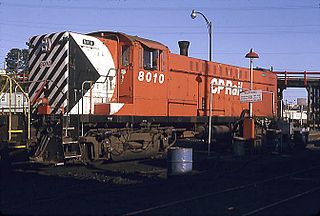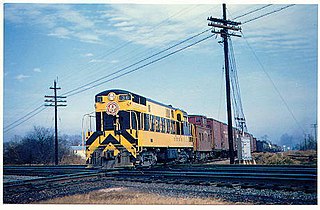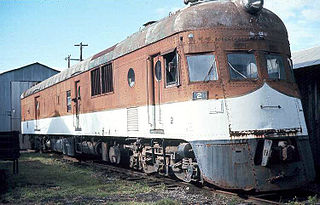
An opposed-piston engine is a piston engine in which each cylinder has a piston at both ends, and no cylinder head. Petrol and diesel opposed-piston engines have been used mostly in large-scale applications such as ships, military tanks, and factories. Current manufacturers of opposed-piston engines include Fairbanks-Morse, Cummins and Achates Power.

The American Locomotive Company was an American manufacturer of locomotives, diesel generators, steel, and tanks that operated from 1901 to 1969. The company was formed by the merger of seven smaller locomotive manufacturers and Schenectady Locomotive Engine Manufactory of Schenectady, New York. A subsidiary, American Locomotive Automobile Company, designed and manufactured automobiles under the Alco brand from 1905 to 1913. ALCO also produced nuclear reactors from 1954 to 1962.

A V18 engine is an eighteen-cylinder piston engine where two banks of nine cylinders are arranged in a V configuration around a common crankshaft.

Fairbanks, Morse and Company was an American manufacturing company in the late 19th and early 20th century. Originally a weighing scale manufacturer, it later diversified into pumps, engines, windmills, coffee grinders, radios, farm tractors, feed mills, locomotives, and industrial supplies until it was purchased by Penn Texas in 1958.

The Canadian Locomotive Company, commonly referred to as CLC, was a Canadian manufacturer of railway locomotives located in Kingston, Ontario. Its works were located on the south side of Ontario Street between William and Gore streets on Kingston's waterfront.

The Consolidation Line was a series of diesel-electric railway locomotive designs produced by Fairbanks-Morse and its Canadian licensee, the Canadian Locomotive Company. Railfans have dubbed these locomotives “C-liners”, however F-M referred to the models collectively as the C-Line. A combined total of 165 units were produced by F-M and the CLC between 1950 and 1955.

The H-24-66, or Train Master, was a diesel-electric railroad locomotive produced by Fairbanks-Morse and its licensee, Canadian Locomotive Company. These six-axle hood unit road switchers were deployed in the United States and Canada during the 1950s.

The ALCO RS-2 is a 1,500–1,600 horsepower (1,100–1,200 kW) B-B diesel-electric locomotive built by the American Locomotive Company (ALCO) from 1946 to 1950. ALCO introduced the model after World War II as an improvement on the ALCO RS-1. Between 1946 and 1950, 377 examples of the RS-2 were built, primarily for American and Canadian customers.
The FM H-12-44TS was a light road switcher version of the Fairbanks-Morse H-12-44 yard switcher. Only three of the 1,200-horsepower (890 kW), six-cylinder opposed piston engine locomotives were manufactured especially for the Atchison, Topeka and Santa Fe Railway in May, 1956. The units had an extended frame to accommodate the addition of a short hood behind the cab, and were configured in a B-B wheel arrangement and mounted atop a pair of two-axle AAR Type-A switcher trucks with all axles powered. H-12-44TSs also came equipped with steam generator units as they were acquired solely for shuttling passenger cars in and around the Dearborn Station terminal in Chicago, Illinois.

The FM H-12-44 was a yard switcher produced by Fairbanks-Morse from May 1950 until March 1961. The units had a 1,200-horsepower (890 kW), six-cylinder opposed piston engine prime mover, and were configured in a B-B wheel arrangement mounted atop a pair of two-axle AAR Type-A switcher trucks, with all axles powered and geared for a top speed of 60 miles per hour (97 km/h).
The FM H-12-46 was a light road switcher of Fairbanks-Morse design manufactured exclusively by the Canadian Locomotive Company from October, 1951–January, 1953 for the Canadian National Railway. Only thirty of the 1,200 hp, six-cylinder opposed piston engine locomotives were produced. The units were configured in an A1A-A1A wheel arrangement, mounted atop a pair of three-axle trucks.

The FM H-10-44 was a yard switcher produced by Fairbanks-Morse from August, 1944–March, 1950. The units featured a 1,000-horsepower (750 kW), six-cylinder opposed piston prime mover, and were configured in a B-B wheel arrangement mounted atop a pair of two-axle AAR Type A trucks, with all axles powered. Many H-10-44s received modifications that increased their horsepower rating to 1,200 hp (890 kW).

The FM H-16-44 was a diesel-electric locomotive produced by Fairbanks-Morse from April 1950 – February 1963. The locomotive shared an identical platform and carbody with the predecessor Model FM H-15-44, and were equipped with the same eight-cylinder opposed piston engine that had been uprated to 1,600 horsepower (1,200 kW). The H-16-44 was configured in a B-B wheel arrangement, mounted atop a pair of two-axle AAR Type-B road trucks with all axles powered. In late 1950, the AAR trucks were almost exclusively replaced with the same units found on the company's "C-liner" locomotives.

The FM H-15-44 was a diesel locomotive manufactured by Fairbanks-Morse from September 1947 to June 1950. The locomotive was powered by a 1,500-horsepower (1,100 kW), eight-cylinder opposed piston engine as its prime mover, and was configured in a B-B wheel arrangement mounted atop a pair of two-axle AAR Type-B road trucks with all axles powered. The H-15-44 featured an offset cab design that provided space for an optional steam generator in the short hood, making the model versatile enough to work in passenger service as well as freight duty.

The FM H-20-44 was a diesel locomotive manufactured by Fairbanks-Morse from June 1947 – March 1954. It represented the company's first foray into the road switcher market. The 2,000 hp (1,490 kW), ten-cylinder opposed piston engine locomotive was referred to by F-M's engineering department as the "Heavy Duty" unit. It was configured in a B-B wheel arrangement mounted atop a pair of two-axle AAR Type-B road trucks with all axles powered. H-20-44s shared the same platform and much of the same carbody as the lighter-duty FM H-15-44, which began its production run three months later.
The Erie-built was the first streamlined, cab-equipped dual service diesel locomotive built by Fairbanks-Morse, introduced as direct competition to such models as the ALCO PA and FA and EMD FT. F-M lacked the space and staff to design and manufacture large road locomotives in their own plant at Beloit, Wisconsin, and was concerned that waiting to develop the necessary infrastructure would cause them to miss out on the market opportunity for large road locomotives. Engineering and assembly work was subcontracted out to General Electric, which produced the locomotives at its Erie, Pennsylvania, facility, thereby giving rise to the name "Erie-built."

The P-12-42, also known as the Speed Merchant, was a streamlined, 1,200 hp (890 kW) locomotive built between 1957–1958 by Fairbanks-Morse, specifically to operate on each end of the Talgo train produced by American Car and Foundry. This model represented F-M's attempted entry into the lightweight locomotive market, but only four of the low-slung units were produced: the first pair was purchased by the New York, New Haven and Hartford Railroad for their John Quincy Adams train, while the second pair went to the Boston and Maine Railroad for their Speed Merchant train.

The OP800 was a lightweight, streamlined railcar built by the St. Louis Car Company in 1939. Fairbanks-Morse supplied the 800 hp (600 kW), five-cylinder 8 in × 10 in opposed piston engine prime mover. The units were configured in a highly unusual 2-A1A wheel arrangement (later converted to 3-A1A) mounted atop a pair of road trucks, and equipped with a front swing coupler pilot. The aft section was divided into two separate compartments: one was used to transport baggage and the other served as a small railway post office, or RPO.

Buda Engine was founded in 1881 by George Chalender in Buda, Illinois, to make equipment for railways. Later based in Harvey, Illinois, Buda from 1910 manufactured engines for industrial, truck, and marine applications. Early Buda engines were gasoline fueled. Later, diesel engines were introduced, utilizing proprietary Lanova cylinder head designs, injection pumps and nozzles. These were known as Buda-Lanova diesel engines. Buda Engine Company was acquired by Allis-Chalmers in 1953. The Buda-Lanova models were re-christened "Allis-Chalmers diesel".
The Fairbanks-Morse 38 8-1/8 is a diesel engine of the two-stroke, opposed-piston type. It was developed in the 1930s, and is similar in arrangement to a contemporary series of German Bombers aircraft diesels. The engine was used extensively in US diesel electric submarines of the 1940s and 1950s, as backup power on most US nuclear submarines, as well as in other marine applications, stationary power generation, and briefly, locomotives. A slightly modified version, the 38ND 8-1/8, continues in service on Los Angeles-, Seawolf-, and Ohio-class nuclear submarines of the US Navy. The 38 8-1/8 has been in continuous production since its development in 1938, and is currently manufactured by a descendant of Fairbanks-Morse, FMDefense, in Beloit, Wisconsin.
























